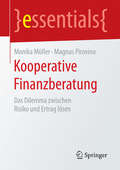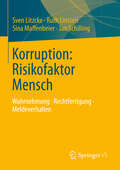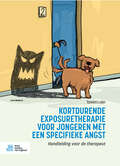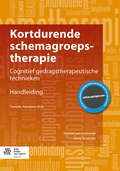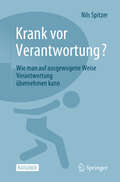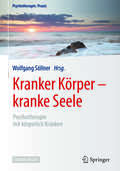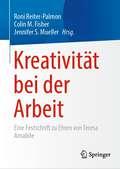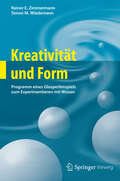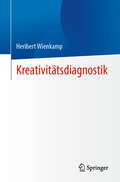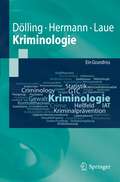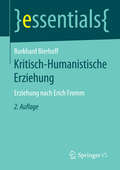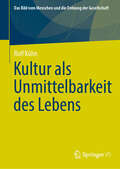- Table View
- List View
Konzept und Berufsbild des Feelgood-Managements (essentials)
by Ulrike Weber Sophia GesingDieses essential f#65533;hrt in das noch wenig bekannte und verbreitete Konzept des Feelgood-Managements, das vor allem in Start-ups entwickelt wurde, sowie das neue Berufsbild des Feelgood-Managers ein. Es zeigt die Chancen auf, durch Feelgood-Management das Engagement der Mitarbeiter sowie die Unternehmens- und F#65533;hrungskultur positiv zu beeinflussen und dadurch die Wettbewerbsf#65533;higkeit weiter zu steigern. Auch werden die Grenzen des Feelgood-Managements und seine m#65533;gliche Weiterentwicklung skizziert. So m#65533;chte das essential einen fundierten als auch praxisorientierten Zugang zum neuen Werteverst#65533;ndnis von Unternehmen erm#65533;glichen. Dabei wird Fachwissen und Expertise aus HR-Management kompetent integriert und neue Wege des Miteinanders aufgezeigt.
Kooperative Finanzberatung: Das Dilemma zwischen Risiko und Ertrag lösen (essentials)
by Monika Müller Magnus PirovinoDieses essential startet mit einer kleinen Geschichte zum Thema Geld und zeigt anschließend das Dilemma zwischen Risiko und Ertrag auf, mit dem jeder Finanzberater konfrontiert ist. Anschließend erläutern die Autoren in einem interdisziplinären Dialog, wie Theorien aus der modernen Physik und Psychologie neue Impulse für die Finanzberatung liefern. Die vorgestellten Perspektiven fördern eine andere Haltung und ein neues Denken: Das Geheimnis des Geldanlegens liegt in einer stabilen und kohärenten Beziehung zwischen Anleger und Anlageberater. Gerade der Zwiespalt zwischen Unsicherheit im Risiko und Ertragsunsicherheit führt zum gemeinsamen Anlageerfolg, weil er einen unumgänglichen, aber gewinnbringenden Dialog in der Finanzberatung auslösen kann.
Kopf gewinnt!: Der Weg zu mentaler und emotionaler Führungsstärke
by Antje HeimsoethDieses Buch zeigt, wie Sie mit Hilfe verschiedener mentaler Techniken an Motivation, Vertrauen, Klarheit, Zielfokussierung und Konzentration gewinnen, Stress und Versagensängste bewältigen, Emotionen regulieren können sowie Entspannung finden. Dabei schlägt die Autorin Brücken zum Spitzensport und lässt Führungspersönlichkeiten, Experten und Spitzensportler zu Wort kommen, die Einblick in ihre Selbstführung gewähren. Konkrete Anleitungen, Übungen und Praxisbeispiele garantieren dem Leser unmittelbare Umsetzungsmöglichkeiten. Selbstbewusstsein, eine konstruktive Einstellung sowie eine gute Selbstführung sind Schlüsselfaktoren für den Erfolg – nicht nur im Business. Das Ziel: Volles Leistungspotenzial abrufen können. Mentales Training stärkt nicht nur das eigene Leistungsvermögen, sondern auch die Lebensqualität und schult die Wahrnehmung für sich selbst und andere.
Koro: Clinical and Historical Developments of the Culturally Defined Genital Retraction Disorder
by Arabinda Narayan ChowdhuryThis book provides a definitive account of koro, a topic of long-standing interest in the field of cultural psychiatry in which the patient displays a fear of the genitals shrinking and retracting. Written by Professor A.N. Chowdhury, a leading expert in the field, it provides a comprehensive overview of the cultural, historical and clinical significance of the condition that includes both cutting-edge critique and an analysis of research and accounts from the previous 120 years published literature. The book begins by outlining the definition, etymology of the term, and clinical features of koro as a culture-bound syndrome, and contextualizes the concept with reference to its historical origins and local experience in Southeast Asia, and its subsequent widespread occurrence in South Asia. It also critically examines the concept of culture-bound disorder and the development of the terminology, such as cultural concepts of distress, which is the term that is currently used in the DSM-5. Subsequent chapters elaborate the cultural context of koro in Chinese and South Asian cultures, including cultural symbolic analysis of associations with animals (fox and turtle) and phallic imagery based on troubling self-perceived aspects of body image that is central to the concept. The second section of the book offers a comprehensive, global literature review, before addressing the current status and relevance of koro, clinically relevant questions of risk assessment and forensic issues, and research methodology.This landmark work will provide a unique resource for clinicians and researchers working in cultural psychiatry, cultural psychology, anthropology, medical sociology, social work and psychosexual medicine.
Korruption: Risikofaktor Mensch
by Ruth Linssen Sven Litzcke Jan Schilling Sina MaffenbeierKorruption ist eine ernstzunehmende Gefährdung für staatliche und ökonomische Systeme. Untersucht werden im vorliegenden Buch daher Wahrnehmungen und Bewertungen von Korruption bis hin zu Rechtfertigungsstrategien und Meldeverhalten in drei verschiedenen Bereichen: Wirtschaft, öffentliche Verwaltung und Sozialwesen. Untersuchte Kausalfaktoren von Korruption sind dabei zum einen Personenfaktoren wie Organisationaler Zynismus, Psychopathie und Intelligenz und situative Faktoren wie Vorteilsgröße, Dauer der Korruptionsbeziehungen oder Gruppen von Nutznießen der Korruptionshandlung. Ein Ergebnis der Untersuchungen ist, dass Korruptionshandeln auf dem Weg zum Kavaliersdelikt ist und zwar trotz der öffentlichen Ächtung von Korruption. Ebenso bietet die interdisziplinär angelegte Studie jedoch auch praktische Ansatzpunkte zur Korruptionsprävention und zur Förderung aktiven Meldeverhaltens bei Mitwisserschaft.
Kortdurende exposuretherapie voor jongeren met een specifieke angst: Handleiding voor de therapeut
by Tamara LuijerDit behandelprotocol beschrijft hoe kortdurende exposuretherapie kan worden toegepast bij jongeren van 12 tot 18 jaar bij wie een specifieke fobie is vastgesteld. Exposure wordt gezien als de gouden standaard voor angstbehandeling. Uit verschillende onderzoeken komt echter naar voren dat exposure bij de behandeling van angstklachten nog te weinig of te weinig effectief wordt ingezet. Kortdurende exposuretherapie voor jongeren met een specifieke angst geeft de therapeut meer inzicht in het belang van exposure, het biedt de nieuwste inzichten op dit gebied, en het geeft concrete handvatten om exposuretherapie zo effectief mogelijk in te zetten. Dit boek begint met een uitleg over specifieke angststoornissen, het protocol en het werkingsmechanisme van exposure. Vervolgens beschrijft het aandachtspunten en mogelijke moeilijkheden die een therapeut kan tegenkomen bij de uitvoering van exposuretherapie. Ten slotte gaat het in op de zes achtereenvolgende behandelsessies en op de twee oudersessies. Bij deze uitgave horen voorbeelden van exposureoefeningen, een vragenlijst omtrent veiligheidsgedrag en online werkbladen voor jongeren.
Kortdurende schemagroepstherapie: Cognitief gedragstherapeutische technieken – Handleiding
by Michiel Van Vreeswijk Jenny BroersenDit boek is een uitgewerkt protocol zoals dat in het kader van diagnose-behandel-combinaties in de GGZ steeds meer wordt gebruikt. De behandeling van mensen met een persoonlijkheidsstornis kan op velerlei manieren gebeuren. Er wordt de laatste jaren veel gewerkt met de mehtode van de cognitieve gedragstherapie; hiervan is schemagerichte behandelmethode een succesvolle in opkomst zijnde therapievorm. Zij is relatief kortdurend en in therapiestappen opgedeeld. In het protocol zijn die stappen concreet uitgewerkt. De resultaten zijn veelbelovend. De methode bestaat uit een handleiding voor therapeuten, waarin de gang van zaken per sessie volledig is uitgeschreven, en een afzonderlijk werkboek voor de cliënten. De handleiding is geschreven voor groepsbehandelingen en van de lezer wrodt verwacht dat hij/zij vertrouwd is met de basale cogniteve-gedragstherapeutische technieken. In hoofdstuk 2 vindt de lezer uiteengezet wat de schemagerichte aanpak van persoonlijkheidsproblematiek inhoudt. Een helder boek met goed toepasbare beschrijvingen en tips.
Kortdurende schemagroepstherapie: Cognitief gedragstherapeutische technieken – Handleiding
by Jenny Broersen Michiel van VreeswijkSchematherapie is een bewezen effectieve behandeling voor patiënten met persoonlijkheidsproblematiek. De groeiende belangstelling naar schematherapie vraagt ook om keuzes maken, ook omdat de ernst van de problematiek als gevolg van schema's en modi divers is. De auteurs van dit boek zijn van mening dat schematherapie zowel langdurend als kortdurend gegeven kan worden. Alleen zo kan schematherapie toegankelijk blijven voor een grote doelgroep van patiënten. De afgelopen jaren is de aandacht van schematherapie in individuele setting ook verschoven naar schemagroepstherapie, een behandelvorm die een ander soort ervaring vraagt van de behandelaar.Kortdurende schemagroepstherapie beschrijft een schema CGT-protocol voor de behandeling van mensen die als gevolg van hun schema's en modi in het leven vastlopen. Dit kan in individuele schematherapie, maar ook in schemagroepstherapie. Bij schemagroepstherapie vindt het interpersoonlijk leren niet alleen plaats in het therapeutisch contact, maar vooral ook in het contact met andere groepsleden. Het aanwezig zijn en werken in en met een groep wordt door zowel therapeuten als patiënten als een krachtige experiëntiële en vaak emotioneel corrigerende ervaring genoemd.In deze herdruk, die voorheen Schemagerichte therapie in groepen heette, worden meer voorbeelden gegeven van groepsdynamische processen en interactief leren. De schema's en modi zijn aangepast aan de laatste ontwikkelingen binnen de schematherapie. De wijze waarop het huiswerk wordt gepresenteerd is overzichtelijker. Verder is het gecombineerde schema/modusmodel nog explicieter uitgewerkt.Dit protocol bestaat uit een handleiding en een werkboek.
Krank vor Verantwortung?: Wie man auf ausgewogene Weise Verantwortung übernehmen kann
by Nils SpitzerDie Verantwortungsfrage wird heute oft gestellt: Wer trägt die Verantwortung für den letzten politischen Konflikt? Wer ist schuld an der Insolvenz der Firma? Wer an der Niederlage gegen den Tabellenletzten? Und schon im Alltag spielt Verantwortung eine große Rolle: Menschen übernehmen sie, wenn sie pünktlich zur Arbeit gehen, den Müll korrekt trennen oder versuchen, nicht zu viel Energie zu verbrauchen. Manche Menschen neigen nun besonders dazu, Verantwortung immer wieder auf die eigenen Schultern zu laden. Eine solche übertriebene Verantwortlichkeit wird inzwischen mit einer ganzen Reihe psychischer Krankheiten in Verbindung gebracht: etwa Depression, generalisierte Angststörung, soziale Phobie oder der Zwangsstörung. Vor allem führt eine ausgeprägte Neigung zur Verantwortungsübernahme schnell zu Überlastung und Burnout. Dieses Buch zeigt Wege auf, die eigene ausgeprägte Neigung, sich selbst (oder auch anderen) Verantwortung zuzuschreiben, zu überwinden – und auf eine gesunde und ausgewogene Weise verantwortungsbewusst zu leben. Aus dem Inhalt: Die guten und schlechten Seiten, Verantwortung zu übernehmen; die eigene Überverantwortlichkeit ausfindig machen; die vielen Gesichter übertriebener Verantwortlichkeit; Übungen zu einer ausgewogenen Verantwortungsübernahme. Über den Autor: Dipl.-Psych. Nils Spitzer ist Psychologischer Psychotherapeut mit eigener Praxis. Er schreibt Bücher und Zeitschriftenbeiträge und ist Dozent in Psychotherapieausbildungen wie auf Fachkongressen.
Kranker Körper - kranke Seele
by Peter Joraschky Wolfgang SöllnerDieses Buch zeigt Praktikern aller Schulen, wie sie auf die besonderen Bedürfnisse körperlich Kranker im therapeutischen Dialog eingehen können und worauf sie bei der Gestaltung der Therapeut-Patient-Beziehung achten sollten. Körperliche Krankheit führt in Abhängigkeit von Schwere und Art der Erkrankung, Erfahrungen mit Lebenskrisen und der Persönlichkeit des Kranken zu Belastungsreaktionen, existenziellen Krisen und Zuständen der Regression. Die Autoren erörtern Schlussfolgerungen für die therapeutische Haltung und Technik und arbeiten dabei mit vielen Fallbeispielen. Insbesondere gehen sie auf die Herstellung des Arbeitsbündnisses, das Nutzen von Krisen als Chance für die Krankheitsverarbeitung, den Umgang mit Angstüberflutung, Trauerprozesse, das Nutzen imaginativer und kreativer Methoden, Suizidgefährdung und spezielle Aspekte des Therapieendes bei existenziell bedrohten Patienten ein.Geschrieben für praktisch tätige und in Aus-/Weiterbildung befindliche ärztliche und psychologische Psychotherapeuten, Fachärzte für Psychosomatische Medizin, Fachärzte für Psychiatrie, Hausärzte, Gesundheitspsychologen, Berater.
Kraus' Recreation and Leisure in Modern Society
by Daniel Mclean Amy HurdIt addresses contemporary issues facing the recreation and leisure profession and focuses on challenges and opportunities that impact the profession now as well as years from now. Extensive research into emerging trends helps support the text and provide insights into the future. Focusing on the ten different types of organizations --ranging from nonprofit community organizations and armed forces recreation to sports management and travel and tourism sponsors -- this classic text text is an invaluable resource for students considering a career in the recreation and leisure industry. New to the Tenth Edition: - Discusses how specific trends, such as dramatic shifts in population make-up, the impact of technology, and marketing affect leisure-service systems and the recreation and park professions. - Focus on the role of parks and recreation on the health and wellness of our communities as well as means to combat the obesity epidemic in North America. - Includes new case studies which allow students to apply knowledge of technology in leisure, identify the value and benefits of play, and recognize the changing family structures of our modern society.
Kreative Übungen in der Ergotherapie: Praxisbuch für die Psychiatrie
by Steffen KerskenDieses Praxisbuch liefert Ergotherapeuten kreative Übungen für den Einsatz in der Psychiatrie. Aus dem Inhalt: Differenzierung von ausdruckszentrierter, kompetenzzentrierter, interaktioneller Methode, Hirnleistungstraining und Arbeitstraining; Arbeiten im interdisziplinären Team; Therapieplanung und Zielsetzung für Einzeltherapie, Kleingruppe, Gruppentherapie, Projektgruppe, Ressourcengruppe; kurze, leicht verständliche Übungsanleitungen und mögliche Varianten. Über 100 kreative Übungen in drei verschiedenen Schwierigkeitsstufen bereichern Ihr Übungsrepertoire für Ihre Patienten in Praxis und Klinik. Plus: Zusatzmaterial zu Trainingsbereichen, Grundfähigkeiten und Überprüfung der Zielerreichung zum Download.
Kreativität bei der Arbeit: Eine Festschrift zu Ehren von Teresa Amabile
by Colin M. Fisher Roni Reiter-Palmon Jennifer S. MuellerDieses Buch bringt führende Wissenschaftler auf dem Gebiet der Kreativität zusammen, um einen Überblick und eine Untersuchung der Arbeit von Teresa Amabile, einer Pionierin der Forschung über organisatorische Kreativität, zu geben. Die Autoren untersuchen die Beiträge von Dr. Amabile zum modernen Studium der Kreativität in Organisationen und ihren Einfluss auf die aktuelle Forschung. Darüber hinaus reflektieren sie, wie ihre Arbeit genutzt werden könnte, um die zukünftige Forschung voranzutreiben, insbesondere in den Bereichen der Komponententheorie und ihrer Erweiterung sowie der konsensuellen Bewertungstechnik. Die Beiträge der Autoren, zu denen sowohl renommierte als auch aufstrebende Wissenschaftler gehören, spiegeln die Breite des Einflusses von Teresa Amabiles Arbeit in den Bereichen der Sozialpsychologie der Kreativität, der Kreativitätsmessung und der Anwendung dieses Wissens auf das Verständnis von Kreativität und Innovation am Arbeitsplatz wider. Dieses Buch ist ein unschätzbares Hilfsmittel für Studenten und Wissenschaftler der Sozialpsychologie, der Kreativitätsforschung, der Arbeits- und Organisationspsychologie, der Wirtschaft und des Managements.
Kreativität in der Schule - finden, fördern, leben (Psychologie in Bildung und Erziehung: Vom Wissen zum Handeln)
by Julia Sophie Haager Tanja Gabriele BaudsonMit Kreativität kann man Neues erschaffen. Ohne Neues geht es nicht weiter. Deshalb muss sie nun auch in der Schule gefördert werden. Und das ist in der schulischen Praxis gar nicht so einfach! Aber was genau ist Kreativität? Wo entstehen die Freiräume für Kreativität im Unterricht und wie kann man Schüler/innen mit kreativer Begabung fördern? Dieses Buch will (angehenden) Lehrkräften, pädagogischen Fachkräften, Psycholog/innen und interessierten Laien helfen, Antworten auf ihre Fragen rund um die Kreativität zu finden. Durch theoretische Ansätze, empirische Befunde und kritische Perspektiven aus Forschung und Praxis zeigen die Beiträge interessierten Leser/innen auf, unter welchen Bedingungen Kreativität wachsen kann und wie sie souverän damit umgehen können.
Kreativität und Form
by Simon M. Wiedemann Rainer E. ZimmermannAusgehend von der Idee des Glasperlenspiels, die Hermann Hesse in seinem gleichnamigen Roman entwirft, haben die Autoren in diesem Band die Möglichkeiten und Grenzen eines solchen Spiels im Umgang mit Wissen ausgelotet. Sie zeigen neue Methoden für das Wissensmanagement auf und verbinden dafür Erkenntnisse verschiedener Wissenschaftsgebiete wie Logik, System- und Erkenntnistheorie sowie Semiotik, Kognition und Kommunikation. Das begleitende Computerprogramm unterstützt Leser beim Experimentieren mit Wissen.
Kreativitätsdiagnostik
by Heribert WienkampZunächst ein zusammenfassender Überblick über die bisherigen Versuche, Kreativität im Rahmen der Intelligenzforschung, der Schulpädagogik, der betrieblichen Eignungsdiagnostik mittels formaler Verfahren wie Tests festzustellen und zu messen, was zum größten Teil misslang. Nach der Klärung des Konstruktes „Kreativität“ und insbesondere Abgrenzung zur Intelligenz und Problemlösefähigkeit, ausloten der Ansätze und Möglichkeiten, Kreativität für Untersuchungen zu operationalisieren und einzuschätzen. Diese Ansätze betreffen sowohl die „Welt der Objekte“ als auch die sozialen Beziehungen, die sich per se meist neuartigen Herausforderungen zu stellen haben. Schließlich erscheint es geboten, Kreativität im Rahmen der Persönlichkeitsdiagnostik insgesamt zu betrachten und zu diskutieren.
Kriminalpsychologie und das Strafrechtssystem in Indien und darüber hinaus
by Sanjeev P. Sahni Poulomi BhadraDieses Buch bietet einen gezielten und umfassenden Überblick über die Kriminalpsychologie in verschiedenen sozioökonomischen und psychosozialen Kontexten. Es informiert die Leser über die Rolle der Psychologie in den verschiedenen Aspekten des Strafrechtsprozesses, angefangen von der Untersuchung einer Straftat bis hin zur Rehabilitation oder Wiedereingliederung des Straftäters. Aktuelle Forschungsergebnisse aus Kriminologie und Psychologie werden erörtert, um die Psyche verschiedener Straftäter zu verstehen, wie man mit ihnen während der Ermittlungen und der Verurteilung effektiv interagieren kann und wie man positive Veränderungen in den verschiedenen Phasen des Strafrechtsprozesses - Ermittlungen, Strafverfolgung, Inhaftierung, Rehabilitation - herbeiführen kann, um die Effizienz des Strafvollzugs zu erhöhen und das Vertrauen der Öffentlichkeit in das Justizsystem zu stärken. Das Buch befasst sich eingehend mit den größeren Problemen einer ganzheitlichen Reduzierung des Anstiegs der Kriminalitätsrate und der Anfälligkeit der Gesellschaft. Jedes Kapitel stützt sich auf führende wissenschaftliche Arbeiten westlicher Wissenschaftler auf diesem Gebiet und ergänzt diese Theorien mit Forschungsergebnissen aus südasiatischer Sicht, insbesondere aus dem indischen Strafrechtssystem. Dieses Buch fasst erfolgreich die Grundlagen der kriminalpsychologischen Literatur zusammen, während es gleichzeitig interdisziplinäre Studien über kriminelles Verhalten und Rechtspsychologie einbezieht und die Lücken des Justizsystems sowie Möglichkeiten für alternative Strafvollzugs- und Rehabilitationsprogramme in den provinziellen Diskurs einbringt.
Kriminologie: Ein Grundriss (Springer-Lehrbuch)
by Dieter Hermann Christian Laue Dieter DöllingDas Lehrbuch vermittelt die Grundlagen der Kriminologie (Begriff, Geschichte und Methoden), erläutert die Kriminalitätstheorien und arbeitet zentrale Befunde zum Verbrechen, zu Tätern und Opfern von Verbrechen sowie zur Verbrechenskontrolle (Kriminalprävention und Strafrechtspflege) heraus. Sodann werden wichtige Deliktsbereiche unter kriminologischen Gesichtspunkten dargestellt. Statistische und methodische Grundlagen empirisch-kriminologischer Untersuchungen werden jeweils berücksichtigt.
Krise in der Lebensmitte
by Volker MünchIn diesem Buch werden die Chancen und Risiken der vielbesprochenen „midlife-crisis“ thematisiert – Therapeuten und Berater erhalten Anregungen für ihre Arbeit und Selbstreflektion. Die unterschiedlichen Formen, die die Durchbrüche des Unbewussten im Alltag von Männern und Frauen annehmen, werden auch anhand klinischer Beispiele genauer untersucht. Wie kann die Jung‘sche Sichtweise dabei helfen, die Hinweise des Unbewussten in kreativer, geduldiger, oft überraschender Weise zu entschlüsseln, zu integrieren und zu nutzen? Diesen Fragen geht der Autor in therapeutischer, persönlicher und gesellschaftlicher Hinsicht nach. Geschrieben für Psychologische Psychotherapeuten, Ärztliche Psychotherapeuten, Berater, Seelsorger. Interessierte Laien können mitlesen.Aus dem InhaltWas ist eine „midlife-crisis“? – Überblick über ein facettenreiches Phänomen – Die Vorstellung des „Puer“ und des „Senex“ – Der Wandel und das „neue Leben“ – Krise als Schwellensituation – Eros und Wandlung – Die Psychologie C.G. Jungs -– Die Therapie der midlife-crisis – Liebe, Körper und Sex und die Lebensmitte – Die Krise unserer Zeit und die Krise der Lebensmitte – Generationalität – Kultur und Lebensmitte – Individuelle Wege zur Lebensmitte.Der Autor Dipl.-Psych. Volker Münch, Psychoanalytiker, eigene psychotherapeutische Praxis in München, Dozent am C.G. Jung-Institut München und C.G. Jung-Institut Stuttgart, Lehranalytiker und Supervisor.
Krisen erfolgreich bewältigen
by Ruth Enzler Denzler Edgar SchulerWie man aus Krisen gestärkt hervorgeht Krisen, Schicksalsschläge und Wertekonflikte lassen sich auch in den Top-Etagen von Politik und Wirtschaft nicht vermeiden. Ruth Enzler Denzler und Edgar Schuler haben namhafte Spitzenführungskräfte interviewt, um herauszufinden, wie diese im Rampenlicht der Medien und der Öffentlichkeit Krisen bewältigen. Dabei unterscheiden sie drei Typen von Menschen anhand ihrer Wertekategorien. Ob jemand um soziale Anerkennung, um Lösungen oder um Rehabilitierung kämpft – alle versuchen gemäß ihrer inneren Haltung Krisen zu überwinden. Die gute Nachricht ist: Für jeden der drei Typen – ob sozial, erkenntnis- oder ordnungsstrukturorientiert – gibt es die passende Strategie, um aus einer Lebenskrise oder scheinbar unlösbaren Situation heraus zu finden! Dieses Buch handelt von Krisen, die erfolgreich bewältigt worden sind, weil sie zu Entwicklungsschritten und tiefgreifenden Veränderungen im Sinne eines persönlichen Reifeprozesses geführt haben. So, dass die Betroffenen sagen können: „Mir geht es besser als davor.“ Das Buch kann Menschen, die in einer persönlichen Krise stecken oder sich aus anderen Gründen für dieses Thema interessieren, ein hilfreicher Ratgeber sein. Interviews mit Sepp Blatter, Susanne Hochuli, Konrad Hummler, Monisha Kaltenborn, Hans Künzle, Eric Sarasin, Rolf Soiron, Silvia Steiner, Monika Stocker und Franziska Tschudi.
Krisenrhetorik und politischer Wandel in China
by Yihong LiuIn diesem Buch wird untersucht, wie das politische System Chinas auf Krisen reagiert. Eine Krise ist ein Ereignis, dessen Auswirkungen nicht allein durch ein geschicktes Management von Zwischenfällen vor Ort kontrolliert werden können, insbesondere in Fällen, in denen weit verbreitete Zweifel an der Legitimität etablierter politischer Paradigmen oder der politischen Ordnung als Ganzes bestehen. Krisen können "politische Fenster" für Interessengruppen schaffen, die die etablierte Politik in pluralistischen Demokratien in Frage stellen. Der politische Kampf zwischen konkurrierenden Definitionen einer unsicheren und mehrdeutigen Situation unter den verschiedenen Akteuren verschafft ihnen einen krisenbedingten Spielraum für dramatische politische Veränderungen. Der Prozess des krisenbedingten politischen Wandels, der hauptsächlich durch die Gestaltung der Krise hervorgerufen wird, ist jedoch in nicht-westlichen Regimen wie China noch nicht ausreichend untersucht worden. Da Chinas Führung die Legitimität des "Sieges" über COVID-19 in den Vordergrund stellt und eine neue Ära der Klimakatastrophen beginnt, wird dieses dynamische Modell der Krise und der Erholung den Wissenschaftlern der chinesischen und globalen Politik Denkanstöße geben.
Kristeva's Fiction (SUNY series, Insinuations: Philosophy, Psychoanalysis, Literature)
by Benigno TrigoWith published work spanning more than forty years, Julia Kristeva's influence in psychoanalysis and literary theory is difficult to overstate. In addition to this scholarship Kristeva has written several novels, however this portion of her oeuvre has received comparatively scant attention. In this book, Kristeva scholars from a number of disciplines analyze her novels in relation to her work in psychoanalysis, interrogating the relationships between fiction and theory. The essays explore questions including, what is the value of experimental writing that escapes easy definition and classification, putting ideas at the same level as character, pacing, plot, suspense, form, and style? And, how might such fiction help its readers overcome the psychological maladies that affect contemporary society? The contributors make a compelling case for understanding Kristeva's fiction as a crucial influence to her wider psychoanalytic project.
Kriterienorientierte Inhaltsanalyse von Zeugenaussagen: Eine empirische Untersuchung zur Validität ausgewählter Glaubhaftigkeitsmerkmale
by Jelena Rönspies-HeitmannIm Jahr 2014 nahmen Volbert und Steller eine Neuordnung der 19 Kriterien der Criteria-Based Content Analysis (CBCA) vor, welche die Kriterien anhand möglicher zugrundeliegender Prozesse in 1. Charakteristika episodischer autobiographischer Erinnerungen, 2. Schemaabweichungen und Schemairrelevanz indizierende Kriterien und 3. Mit strategischer Selbstpräsentation asssoziierte Kriterien gruppierte. Volbert und Steller formulierten hierzu die Annahme, dass Kriterien aus der 1. Gruppe grundsätzlich auch in konfabulierten Aussagen auftauchen sollten, während Kriterien der zweiten Gruppe von Falschaussagenden vermieden werden sollten. Die vorliegende Studie untersuchte anhand einer Simulationsstudie, inwiefern sich diese Annahmen bestätigen lassen und ob eine literaturbasierte Erfassung kriterienimmanenter Steigerungsformen der Aussagequalität die Validität der Kriterien aus Gruppe 1 möglicherweise verbessern kann. 248 Schüler*innen erlebten oder konfabulierten den Ablauf eines dyadischen Interaktionsspiels und wurden anschließend ausführlich dazu befragt. Die von Volbert und Steller (2014) formulierte Annahme einer überlegenen Validität von auf Schemaabweichungen basierenden Kriterien ließ sich dabei anhand einzelner Kriterien insgesamt bestätigen.
Kritisch-Humanistische Erziehung: Erziehung nach Erich Fromm (essentials)
by Burkhard BierhoffKann Erziehung freie Menschen hervorbringen? In diesem "Erziehungs-Manifest" sollen einige Argumentationslinien Erich Fromms nachvollzogen und für die Pädagogik als Wissenschaft und Praxis erschlossen werden. Eine gelungene Erziehung im Sinne von Fromm hilft dem Menschen, eine authentische Identität zu entwickeln, fördert seine kritischen Fähigkeiten und unterstützt den kreativen Ausdruck seiner Persönlichkeit. Ziel ist der freie Mensch, der gegenüber Manipulation und Einschüchterung immun ist und sich mit Liebe und Vernunft der Welt zuwendet. Die Beschäftigung mit Fromm bietet für ein solches Erziehungskonzept viele produktive Anregungen.
Kultur als Unmittelbarkeit des Lebens (Das Bild vom Menschen und die Ordnung der Gesellschaft)
by Rolf KühnBestimmt man radikal phänomenologisch die Kultur als Subjekt wie Objekt ihrer selbst, dann beinhaltet dies eine jeweils gegebene Unmittelbarkeit des Lebens als Originarität aller subjektiv kulturellen Vollzüge. Dies wird methodisch in Auseinandersetzung mit empirischen wie transzendentalen Kulturanalysen wie bei Freud, Husserl, Henry und Derrida aufgegriffen, um sich danach inhaltlichen Manifestationen der Kultur wie Religion, Wissenschaft und Ästhetik zuzuwenden. Leitend bleibt dabei für die Zukunftsbestimmung unserer Kultur eine notwendige ko-pathische Aufmerksamkeit für das Leben, welche die Singularität aller kulturellen Vollzüge über die diskursive Begrenztheit eines rein objektivierenden Verständnisses hinaus am Werk sieht. Dabei wird auch dem Imaginären wie Fiktionalen ihr unumgehbares Recht eingeräumt, wie es besonders in der Kunst als Meta-Genealogie des Individuums und der Gemeinschaftlichkeit zum Ausdruck kommt.

